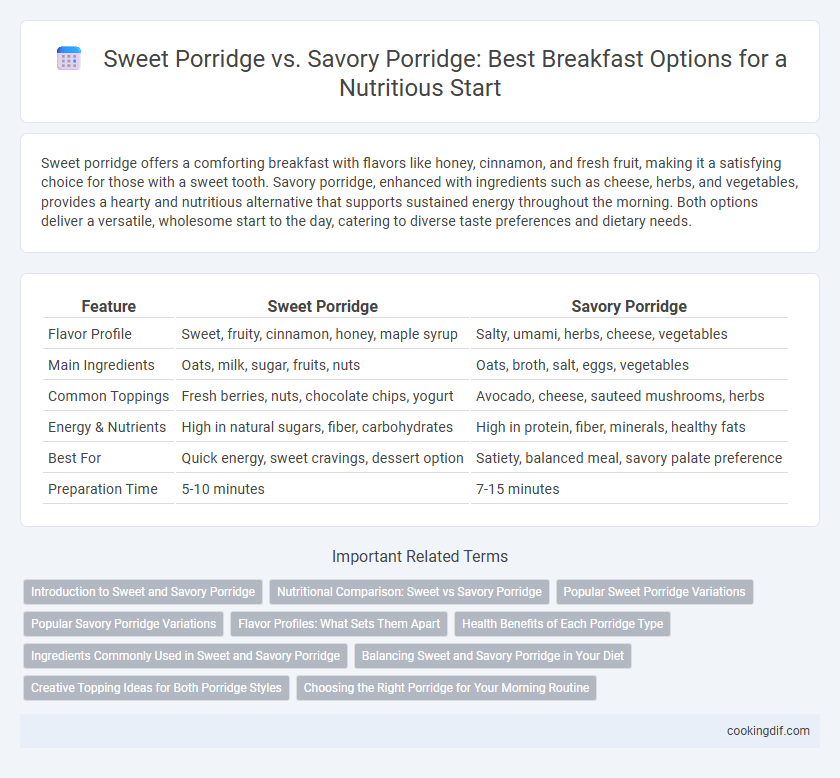Sweet porridge offers a comforting breakfast with flavors like honey, cinnamon, and fresh fruit, making it a satisfying choice for those with a sweet tooth. Savory porridge, enhanced with ingredients such as cheese, herbs, and vegetables, provides a hearty and nutritious alternative that supports sustained energy throughout the morning. Both options deliver a versatile, wholesome start to the day, catering to diverse taste preferences and dietary needs.
Table of Comparison
| Feature | Sweet Porridge | Savory Porridge |
|---|---|---|
| Flavor Profile | Sweet, fruity, cinnamon, honey, maple syrup | Salty, umami, herbs, cheese, vegetables |
| Main Ingredients | Oats, milk, sugar, fruits, nuts | Oats, broth, salt, eggs, vegetables |
| Common Toppings | Fresh berries, nuts, chocolate chips, yogurt | Avocado, cheese, sauteed mushrooms, herbs |
| Energy & Nutrients | High in natural sugars, fiber, carbohydrates | High in protein, fiber, minerals, healthy fats |
| Best For | Quick energy, sweet cravings, dessert option | Satiety, balanced meal, savory palate preference |
| Preparation Time | 5-10 minutes | 7-15 minutes |
Introduction to Sweet and Savory Porridge
Sweet porridge typically incorporates ingredients like fruits, honey, cinnamon, and nuts to create a naturally flavored breakfast rich in antioxidants and fiber. Savory porridge, on the other hand, blends grains such as oats or millet with vegetables, herbs, and proteins like eggs or cheese, offering a balanced meal that supports sustained energy release. Both variations provide versatile, nutrient-dense options tailored to diverse dietary preferences and nutritional needs.
Nutritional Comparison: Sweet vs Savory Porridge
Sweet porridge, often made with fruits, honey, or maple syrup, provides quick energy from natural sugars and a good source of vitamins and antioxidants, while savory porridge includes ingredients like eggs, cheese, or vegetables which offer higher protein and healthy fats for sustained fullness. The glycemic index of sweet porridge tends to be higher, causing faster blood sugar spikes compared to savory porridge that promotes stable energy levels due to its balanced macronutrients. Both options contribute essential nutrients, but savory porridge is generally preferred for those seeking improved satiety and slower energy release during breakfast.
Popular Sweet Porridge Variations
Popular sweet porridge variations include classic oatmeal with honey and cinnamon, creamy rice porridge topped with fresh berries, and millet porridge flavored with vanilla and dried fruits. These options provide natural sweetness and essential nutrients, making them ideal for a quick and energizing breakfast. Incorporating nuts, seeds, or a drizzle of maple syrup enhances texture and flavor while boosting protein and healthy fats.
Popular Savory Porridge Variations
Savory porridge offers diverse and nutrient-rich breakfast options, featuring popular variations like congee with chicken and ginger, Turkish muhammara with bulgur, and Japanese okayu topped with pickled vegetables. These savory versions provide a balanced combination of proteins, vegetables, and spices, delivering robust flavors and sustained energy. Incorporating ingredients such as green onions, mushrooms, soy sauce, and eggs enhances the taste profile while boosting vitamins and minerals essential for a wholesome morning meal.
Flavor Profiles: What Sets Them Apart
Sweet porridge features natural sugars, fruits, honey, or spices like cinnamon and nutmeg, creating a rich, aromatic flavor that appeals to those with a sweet tooth. Savory porridge incorporates ingredients such as cheese, herbs, vegetables, or meats, delivering a hearty, umami-packed taste that satisfies more robust breakfast cravings. The contrast between the sweet and savory flavor profiles lies in their core ingredients and seasoning, offering versatile options tailored to individual palate preferences.
Health Benefits of Each Porridge Type
Sweet porridge, rich in fruits and natural sweeteners like honey or maple syrup, provides antioxidants, vitamins, and quick energy, promoting a boost in metabolism and mood. Savory porridge, often prepared with vegetables, herbs, and proteins such as eggs or legumes, offers higher satiety, essential minerals, and balanced macronutrients, supporting sustained energy and muscle health. Both options contribute to gut health through dietary fiber, aiding digestion and maintaining stable blood sugar levels.
Ingredients Commonly Used in Sweet and Savory Porridge
Sweet porridge often features ingredients like cinnamon, honey, berries, nuts, and vanilla to create a naturally sweet flavor profile. Savory porridge typically includes ingredients such as cheese, herbs, sauteed vegetables, eggs, and spices like black pepper or cumin for a hearty, flavorful breakfast option. Both variations use oats or other grains as a base, allowing flexibility in texture and nutritional content.
Balancing Sweet and Savory Porridge in Your Diet
Balancing sweet and savory porridge in your diet enhances nutritional diversity and satisfies varied taste preferences, providing a mix of carbohydrates, fiber, and essential nutrients. Sweet porridge, often enriched with fruits, honey, or nuts, offers natural sugars and antioxidants, while savory porridge with ingredients like eggs, vegetables, or cheese delivers protein and healthy fats. Incorporating both types ensures a well-rounded breakfast that supports sustained energy and satiety throughout the morning.
Creative Topping Ideas for Both Porridge Styles
Sweet porridge toppings like fresh berries, honey, sliced almonds, and chia seeds add natural sweetness and texture, creating a nutritious and visually appealing breakfast bowl. Savory porridge can be elevated with toppings such as sauteed mushrooms, avocado slices, grated cheese, and a poached egg, offering a protein-packed and flavorful start to the day. Incorporating herbs like chives or parsley in savory porridge and cinnamon or nutmeg in sweet porridge enhances aroma and depth, making each bowl uniquely satisfying.
Choosing the Right Porridge for Your Morning Routine
Sweet porridge, often made with ingredients like honey, fruits, and cinnamon, provides a quick energy boost through natural sugars and is ideal for those preferring a light, flavorful breakfast. Savory porridge incorporates vegetables, herbs, and proteins such as eggs or cheese, offering sustained satiety and balanced nutrients crucial for prolonged focus during the morning. Selecting the right porridge depends on individual dietary goals and taste preferences, with sweet options favoring fast energy and savory varieties supporting fullness and nutrient diversity.
Sweet porridge vs savory porridge for breakfast options Infographic

 cookingdif.com
cookingdif.com